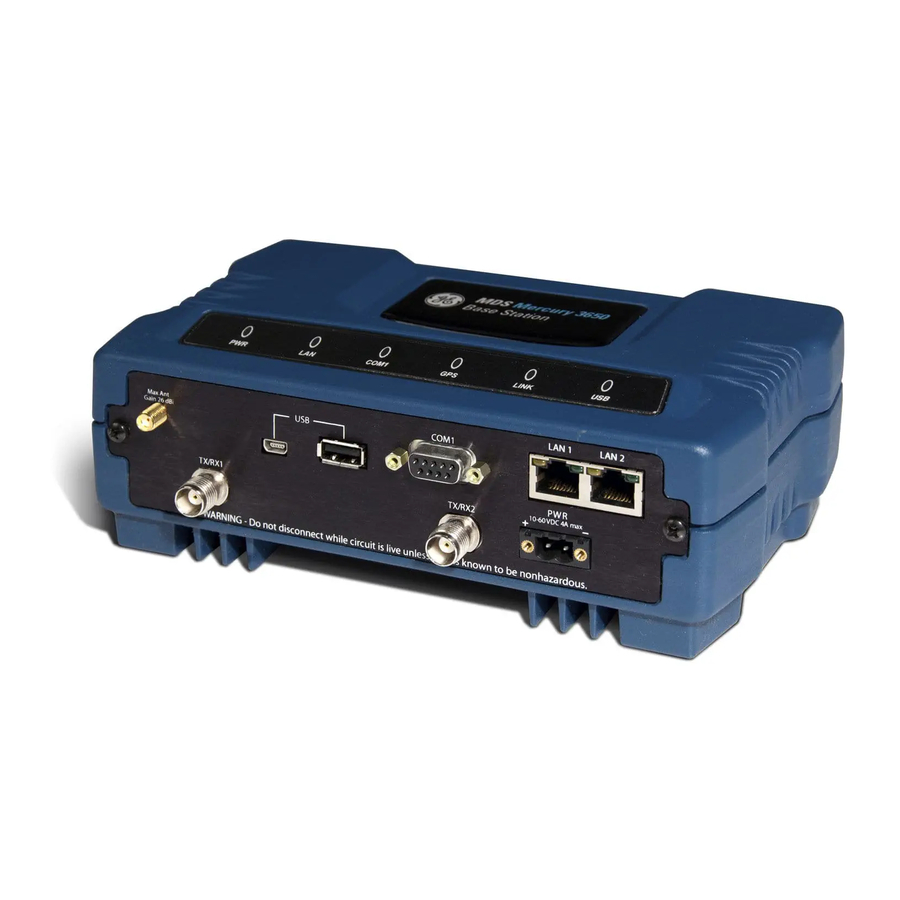
GE MDS Mercury Series Setup Manual
Hide thumbs
Also See for MDS Mercury Series:
- Setup manual (4 pages) ,
- Reference manual (76 pages) ,
- Reference manual (196 pages)
Advertisement
Quick Links
1.0
INTRODUCTION
MDS Mercury
TM
Series transceivers provide an easy-to-install
wireless network service with long range and secure operation at
adaptive data rates approaching 30 Mbps. The transceiver is
designed for demanding applications in industrial environments,
where reliability and range are paramount.
The transceiver comes in two primary models—Base Station (BS)
and Subscriber Unit (SU), each with unique hardware profiles.
Both models support Ethernet and serial services.
A BS is a wireless switch that usually provides connectivity into a
wired Ethernet LAN/WAN. Subscriber Units associate over the air
with a BS and are typically connected to an Ethernet or Serial
device via a local cable.
NOTE: To determine whether a unit is an BS or Subscriber Unit,
check the dome label on the top of the unit.
Refer to the Mercury Series Technical Manual (05-6302A01) for
advanced procedures and cautionary information.
1.1
Connectors & Indicators
Figure 1
shows the connectors and indicators of a Standard BS.
These items are referenced in the installation and operation steps
that follow. Note that SU radios may have an additional connector
present for WiFi service, depending on order requirements. If WiFi
is not provided on an SU, the GPS connector will also be absent.
USB PORTS
(Mini-A, Type-A)
LED INDICATOR
PANEL
GPS ANTENNA
CONNECTION
Figure 1. Connectors and Indicators
(Standard BS shown; SU Similar)
2.0
INSTALLATION
There are three main requirements for installing the transceiver—
adequate and stable primary power, a good antenna system, and
the correct interface between the transceiver and the data device.
Figure 2
shows a typical Mercury installation.
05-6301A01, Rev. 01
Invisible
place
holder
RS-232
SERIAL PORT
LAN PORTS
DC INPUT
(10–60 VDC, 4A MAX)
WiMAX RF
CHANNEL 2
WiMAX RF
CHANNEL 1
MDS Mercury Series Quick Start
MDS Mercury Series
2.1
Installation Steps
Listed below are the basic steps for installation. It is highly recom-
mended that the BS be installed first so that you can quickly check
the operation of each associated SU as it is placed on the air.
RTU/PLC
Crossover Cable
to Radio
PC RUNNING
TERMINAL
PROGRAM
TO DC POWER SUPPLY
(Straight-Through
Cable to Radio)
Figure 2. Typical Mercury Installation (SU Shown; BS Similar)
2.1.1
Step 1—Mount the Transceiver
Use the supplied 6-32 x 1/4 inch (6 mm) screws to attach the
mounting brackets to the bottom of the radio.
mounting dimensions of the unit. Mount the radio to a stable sur-
face. (Fasteners not supplied.)
Invisible place holder
Figure 3. Transceiver Mounting Dimensions
(Dimensions for BS and SU identical)
2.1.2
Step 2—Install the Antenna
Base units typically use sector antennas, while SU's typically use
a directional panel antenna. All antennas should be mounted in the
clear to a sturdy support. Connect the antenna's feedline cable to
the transceiver's WiMAX Antenna Port. To minimize RF interfer-
ence, the antenna should be at least 9 inches (> 23 cm) away from
connected device(s), sensors and other external components.
Setup Guide
Invisible
place
holder
ANTENNA SYSTEM
Subscriber: Panel Ant.
Base Unit: Sector Ant.
TO GPS ANTENNA
(Provides 3.3 Vdc output)
(10–60 Vdc)
Figure 3
shows the
8 5/8˝ (21.8 cm)
1
Advertisement

Summary of Contents for GE MDS Mercury Series
-
Page 1: Setup Guide
Mercury installation. the transceiver’s WiMAX Antenna Port. To minimize RF interfer- ence, the antenna should be at least 9 inches (> 23 cm) away from connected device(s), sensors and other external components. 05-6301A01, Rev. 01 MDS Mercury Series Quick Start... - Page 2 Enter the username and password. If above checks are OK, you are finished with the installation at this site. Review other settings and make changes as necessary, such as the unit password, IP address, and security. MDS Mercury Series Quick Start 05-6301A01, Rev. 01...
- Page 3 Any unauthorized modification or communication in the network. RSSI measurements and Wireless changes to this device without the express approval of GE MDS Packet Statistics are based on multiple samples over a period of may void the user’s authority to operate this device. Furthermore, several seconds.
- Page 4 100 Mbps operation. GE MDS, LLC 175 Science Parkway Rochester, NY 14620 MDS Mercury Series Setup Guide General Business: +1 585 242-9600 05-6301A01, Rev. 01 FAX: +1 585 242-9620 November 2010 (Copyright 2010, GE MDS, LLC) Web: www.gemds.com...















